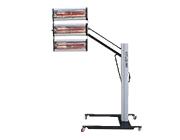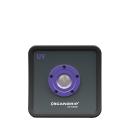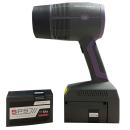UV bodywork lamps

UV lamps for bodywork
︾
Bodywork UV lamp: everything you need to know about how it works and how to use it in the car workshop:
In car bodywork workshops, a UV lamp is mainly used to accelerate the drying and polymerisation of certain products, such as putties, primers or Clearcoats specially formulated for curing by ultraviolet radiation.
How a bodywork UV lamp works :
1. Basic operating principle :
- The lamp emits UV-A radiation (wavelength 320-400nm).
- UV products (putties, primers, Clearcoats) contain photoinitiators, i.e. molecules that are sensitive to UV light.
- When exposed to UV light, these photo initiators trigger a chemical polymerisation reaction: the product hardens instantly.
- Result: very fast drying (a few seconds to a few minutes) without excessive heat
2. Steps for use in a body shop :
- Application of a UV product (putty, primer or Clearcoat)
- Position the lamp at a recommended distance (often between 10 and 40cm)
- Exposure to UV light for the time specified by the manufacturer
- Complete curing: the product is ready to be sanded or coated immediately, unlike air-cured products.
3. Precautions when using the UV lamp for bodywork :
- Always wear UV protection goggles and gloves if necessary.
- Do not expose skin directly to UV rays
- Respect the distance and exposure time recommended by the product manufacturer.
A UV lamp for bodywork works by emitting ultraviolet light which activates the photoinitiators contained in the specific products (putties, primers, Clearcoats). This process triggers an ultra-fast polymerisation, allowing instant, economical and effective drying, ideal for fast, localised repairs.
What are the advantages of using a UV lamp in a bodywork workshop?
UV lamps have a number of advantages for car bodywork repairs. Here's a summary:
1. Fast drying:
- UV products (putties, primers, specific Clearcoats) harden in a matter of seconds to a few minutes, which saves a considerable amount of time on repairs or Touch up.
- There's no need to wait 30 to 60 minutes as with thermal curing.
- It also improves workshop productivity and reduces vehicle downtime.
2. Energy savings:
- Unlike a paint booth, which has to heat an entire volume of air, the UV lamp consumes much less energy
- Ideal for workshops looking to cut costs and reduce their carbon footprint
3. Spot repair:
- Allows you to treat only the area concerned, without immobilising the whole vehicle
- Extremely useful for small dents, scratches or local touch-ups
- Increases flexibility and productivity in the workshop
4. High-quality finish :
- UV curing ensures even and complete polymerisation of the product
- No risks associated with temperature variations (bubbles, blisters, cracks)
- Surface immediately ready for sanding, polishing or coating
5. Environmentally friendly :
- Less CO2 emissions than booth drying
- Reduced gas or electricity consumption
- Compatible with low-VOC UV products (low solvent content)
6. Safety and working comfort :
- No release of excessive heat as with infrared lamps or booths
- Quick and easy to use, without time-consuming adjustments
UV lamps for bodywork provide fast, economical and environmentally-friendly drying, while offering superior finish quality and greater productivity. They are particularly suited to workshops that carry out rapid, localised repairs.
How long does it take to dry with a UV lamp?
1. Depending on the type of UV product:
- UV Putty: 30 seconds to 2 minutes exposure time
- UV Primers: 1 to 3 minutes depending on the thickness of the layer
- UV Clearcoats: 2 to 3 minutes on average
Once exposure is complete, the surface is thoroughly cured and can be sanded, polished or coated immediately.
2. Depending on lamp power and technology:
- LED lamps: Fast drying, low heat release: often 30 seconds to 2 minutes for a small area
- Traditional UV lamps: up to 5 minutes but may cover a larger area
3. Depending on distance and surface treated :
- Optimum distance: generally between 10 and 40cm from the surface
- The larger the surface, the longer it may take, as the lamp may need to be moved to cover the entire area.
With a UV bodywork lamp, drying time varies from 30 seconds to 5 minutes, depending on the product applied, the power of the lamp and the surface treated. This makes it an ideal solution for spot repairs.
What are the characteristics of a UV lamp in bodywork?
1. Type of radiation :
- UV-A: 320 to 400m: used in bodywork, as it is effective in activating the photoinitiators of UV products, and is harmless.
- Some older lamps could emit UV-B, but they are less suitable and more aggressive.
2. Lighting technology :
- UV-A LEDs: modern, lightweight, low consumption, long life, Fast drying (30 sec to 3 min)
3. Power and intensity :
- Expressed in watts (W) for light intensity.
- UV LED lamps generally range from 30W to 200W depending on size.
- The higher the wattage, the quicker and more effective the drying over a large area.
4. Coverage area :
- Small portable lamps: cover a localised area (spot repair)
- Tripod or frame-mounted UV lamps: can treat larger areas
5. Drying time :
- 30 seconds to 5 minutes depending on product and lamp power
- Immediately ready for Sanding, Polishing or Covering
6. Ergonomics and mobility :
- Portable models: pistol, hand-held lamp, very light
- Stationary models: mounted on an articulated arm or trolley to cover a wing or bonnet
7. Safety and protection :
- Built-in filters to limit dangerous UV
- Need to use UV protection goggles
- Some lamps incorporate an automatic timer system to prevent overexposure.
8. Durability and power consumption :
- UV LEDs: life of up to 30,000 to 50,000 hours, very low power consumption
- Halogen lamps: higher energy consumption and shorter lifespan
How much does a UV lamp cost?
The price of a UV lamp for bodywork varies greatly depending on its power, technology and functionality, and whether it is a professional or more basic model.
For example, General Pneumatic's compact UV/LED lamp, the Nova-UVS, costs around €390 excluding VAT. This is a professional LED lamp with a runtime of around 1.5 hours and a Li-Ion battery.
What bodywork repairs can UV lamps be used for?
UV bodywork lamps are designed to cure specific products quickly. They do not replace a full booth, but are ideal for quick, localised repairs.
1. Spot repairs :
- Small paint chips (stone chips, impacts)
- Light to medium scratches
- Touching up a panel without repainting the whole room
- The UV lamp hardens primer + Clearcoat in just a few minutes, for immediate Refinishing.
2. Use with UV putties :
- Filling dents (on plastic, metal or aluminium)
- Spot-repair dents with local puttying
- Dries in 30 sec-2 min, direct sanding afterwards
3. Use with UV Primers :
- Preparation of sanded areas before painting
- Local corrections after minor sanding or rework
- Fast drying (1-3 min), can be painted directly afterwards
4. Use with Clearcoats :
- Clearcoat for Touch up on small surfaces (bumper, door, wing)
- Quick repairs around the edges, without immobilising the vehicle
- Provides lasting protection for the repair and allows the car to be delivered almost immediately
5. Special substrates :
- Plastic (bumpers, mirror caps)
- Aluminium (body parts)
- Modern steels (body parts)
- UV products are often multi-substrate, and cure evenly.
To sum up, a UV lamp in bodywork is mainly used for :
- UV Putty = filling small defects quickly and effectively
- UV primers = to prepare a localised area
- Clearcoat UV = protecting and finishing a Touch up
So it's a perfect solution for local repairs, without having to go through a full cabin cycle, which greatly reduces vehicle downtime.
This professional equipment delivers high performance in the automotive workshop. The lamps ensure that the materials on your vehicle are properly dried. You'll get a high level of quality by being equipped with professional tools.

